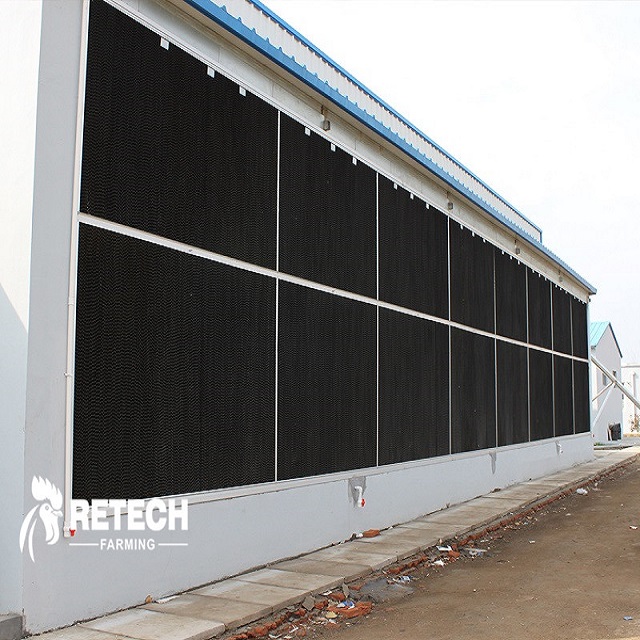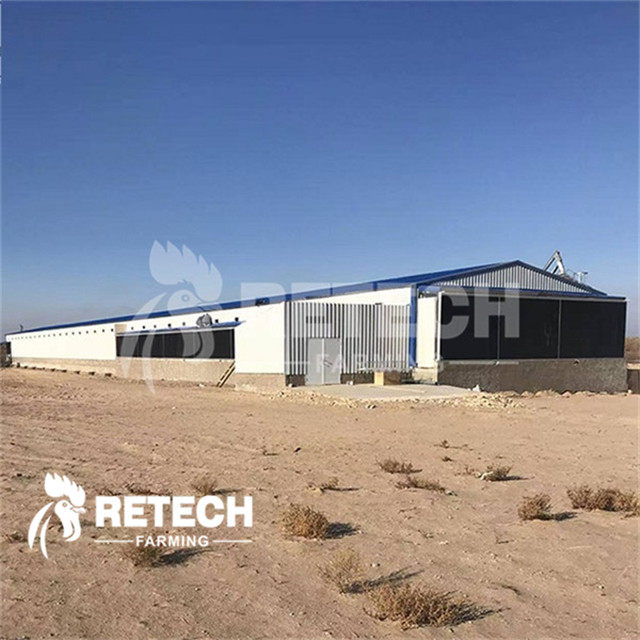Close search
 Published :
/
Published :
/ Posted by : Retech
Posted by : RetechIn summer, the premise of effective ventilation of the house is to maintain airtightness, allowing fresh air to enter the house from the required place (side wall vent or wet curtain).
Therefore, the farm area is required to check the airtightness of each chicken house, especially the doorway in the middle of the chicken house, the manure baffle, the connection between the wet curtain and the chicken house, etc.
Tunnel ventilation must ensure that air should enter the house from both sides of one end of the house, not only from one side.
The air entering the house from both sides can fully mix the air in the house, and there will be no ventilation dead ends.
Only when a certain negative pressure is formed in the chicken house can the ventilation openings entering the chicken house have a certain wind speed. The horizontal ventilation requires a wind speed of 3 to 5 meters per second. At the wet curtain of vertical ventilation, the wind speed through the curtain is 1.5 meters per second. ~2 meters, the wind speed of the chicken back is required to be 2 to 3 meters per second.
The maximum wind speed on the back of the chicken cannot exceed 3 meters per second. If it exceeds 3 meters, the chickens are prone to bad symptoms.
The farm area should observe and record the negative pressure of the chicken house to prevent the negative pressure of the chicken house from being too large.
In addition, the air intake pipe connected to the negative pressure controller should not be placed in the workshop in the middle of the house, but must be placed outside and connected to atmospheric pressure.

If the temperature difference between day and night is too large or the weather is unpredictable, mixed ventilation needs to be used to ensure the temperature of the chicken house.
Therefore, when transitioning from horizontal vents to vertical vents, we must pay attention to the management of air inlets.
When the fan starts from the first level to the second level or the third level, the corresponding air inlet must be adjusted to reduce the negative pressure of the chicken house, so that the wind speed and temperature are uniform before and after the chicken house.

Air movement over the bird creates a convective cooling effect that removes moisture released by the bird's normal breathing and panting.
The flow rate of air throughout the house can have a "cooling effect" on the birds.
Whether the ventilation management of the chicken house is effective, and whether the chickens are comfortable, can not only look at the temperature displayed by the thermometer and the thermostat, but must pay attention to the body temperature of the chickens.
Special reminder: The best way to judge whether the environmental intensity of the chicken house is appropriate and whether the chickens are healthy and comfortable is to observe the chickens, that is, to understand the comfort of the chickens according to whether the chickens are normal in terms of feeding, drinking, singing, and mental state. .
The faster the air velocity, the greater the gap between the chicken's body temperature (low) and the thermometer's recorded value (high); the younger the chicken, the greater the "air cooling effect" caused by the wind speed.
Therefore, as a farm manager, you must understand what is normal and what is abnormal in your chicken flock. You must often enter the chicken house to observe, evaluate, and feel whether the smell and temperature of the chicken house are appropriate, especially before and after turning on the lights in the morning, to judge the ventilation rate. Is it appropriate.
It is recommended that the temperature of the chicken house be kept at 22℃~24℃, and when the temperature reaches above 32℃, all the fans in the chicken house can start to start, so the difference between the fans at all levels must be set reasonably to avoid frequent start of the fans.
The temperature probe is placed 20 cm from the back of the caged chickens on the coop. Clean the probe weekly with a dry rag to remove dust and ensure sensitive strength.
Maintenance of ventilation and cooling equipment.
Regularly perform reasonable maintenance and maintenance on the ventilation and cooling equipment of the chicken house to ensure the best performance.
Develop equipment maintenance plans and procedures according to the actual conditions of the site, such as cleaning of black hoods, shutters, and fan blades, cleaning of wet curtain pool water, adjustment and replacement of belts, and commissioning and maintenance of generators.